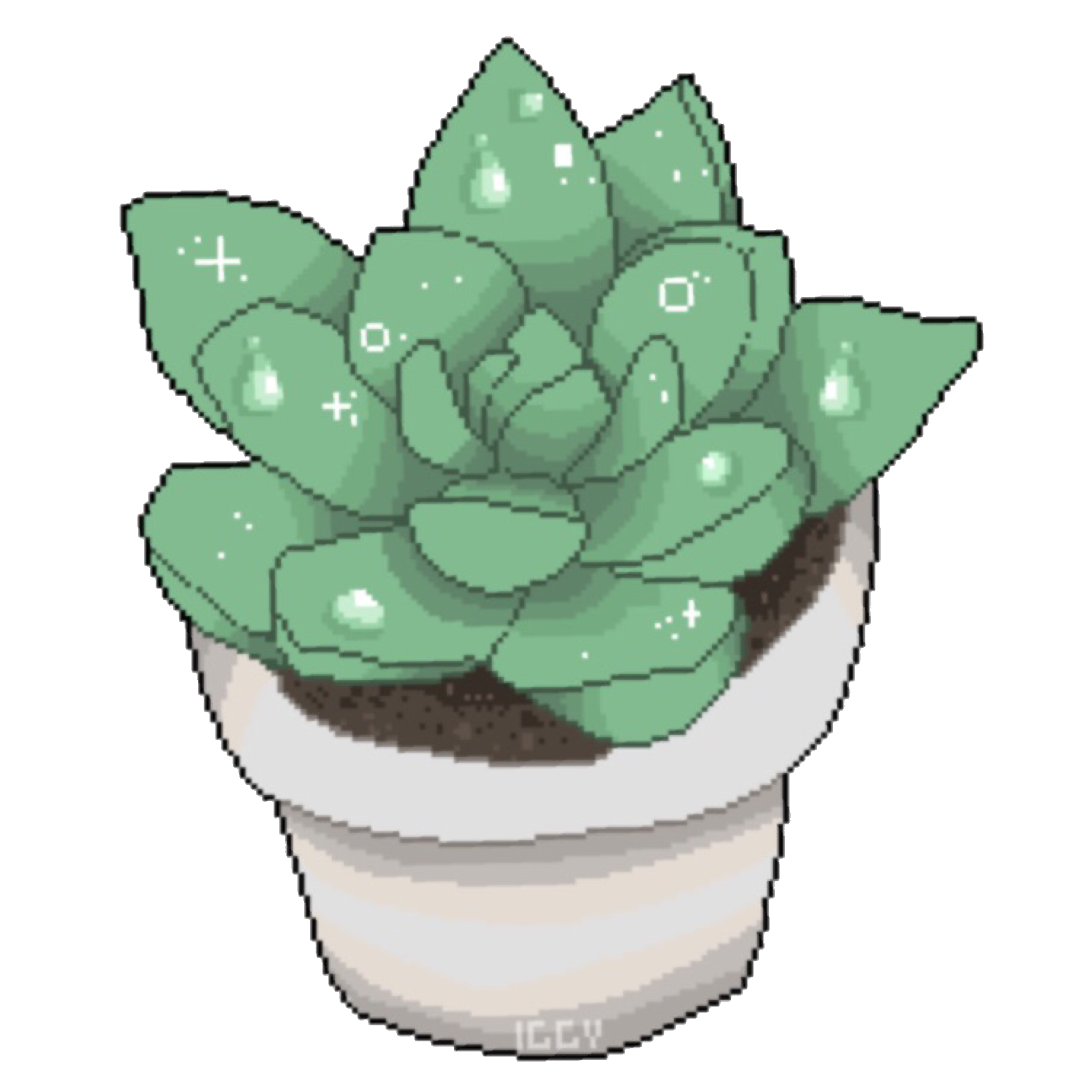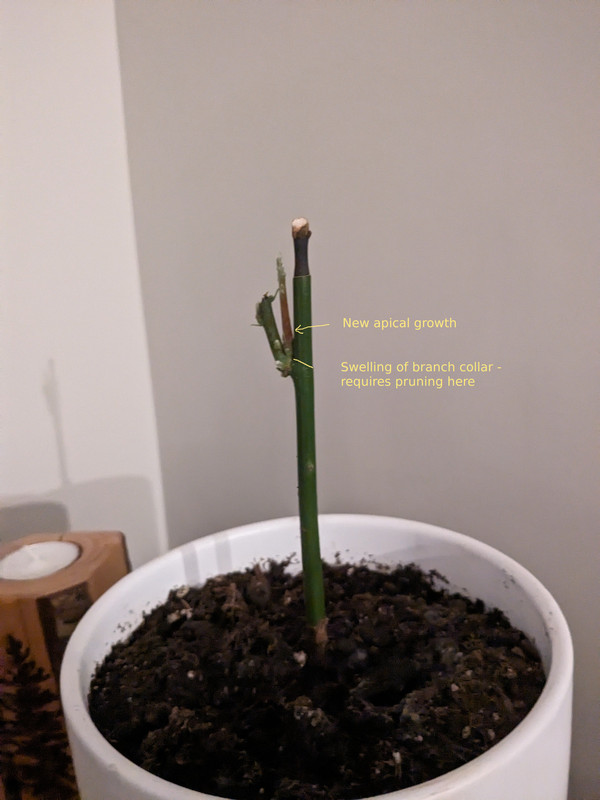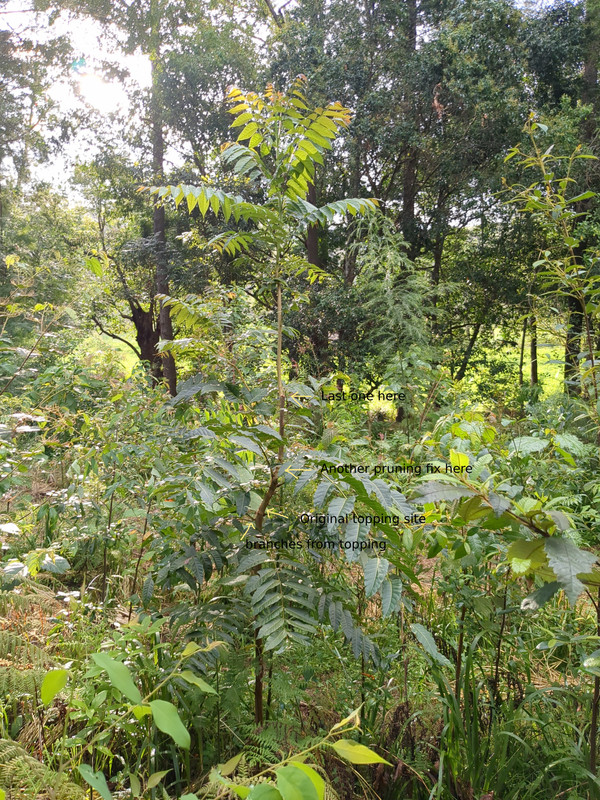Treevan 🇦🇺
- 1 Post
- 13 Comments

 22·7 months ago
22·7 months agoThere is no reason why you can’t resume apical growth. It looks to be recovering as is. It is difficult to tell, but the pinkish growth is new, yes? That is what will resume growing as your “main trunk”.
You can see the angled swelling above the node, that is the branch collar you need to every so slightly cut at, or minutely above. This is where the callous wood will form to compartmentalise the wound. As the stub you have cut is so long, the tree will will have to wait for the stub to die and drop off before closing.
First step is prune at the collar “target”. Then you will let tree recover for a while and dictate what new growth will resume the vertical trunk that you want. You will then select and encourage that growth to resume being the main trunk. You won’t be pruning anything for a while after your first cut, you need the tree to recover. Most pruning events are annual and never more than 25% of total canopy loss. Note on pic, zoom in.
I don’t know what the other commentators mean with their comments, this is fairly standard arboricultural pruning practices. If anything they said was true, any tree other than a mature conifer that suffered minor “topping” damage in the wild would be an instant death sentence for the tree. This is not the case in a majority of situations.
For a real world example, here is a tree that was topped by a moth and the pruning that I did to recover it. I pruned some of the new branches at the wound to encourage the upper growth. There are notes on pic, you need to zoom in,
Edit: Just went to neighbours house and they have a roughly pollarded Avocado. You can see the multiple regrowth points, you would select one of these to be the new trunk. Just a good demonstration of the same species getting on with it.

 8·7 months ago
8·7 months agoI got it during a websearch. Changed VPN server to another city and it went away. Mullvad.

 18·8 months ago
18·8 months agoI live in an area that was 95% cleared of rainforest. Our clearing rate is now near zero (but not zero), much success for everyone.
Are we going to restore it?
No. Farmers don’t want to.

 4·8 months ago
4·8 months agoIf it’s going to be in the same pot for a long time, I would make an inorganic mix to prevent compaction and rotting of the materials (usually pine bark is the culprit).
Something like 50% horticultural sand, 25% aeration (pumice or perlite - perlite if it’s a small pot, pumice if it’s a big pot), 25% water holding (sphagnum, coir). Then you can either mix in a long lasting chem fertiliser, or use water-based frequently, or top dress with organics when required.
Looks like Aussie.Zone has the most mentions of koalas.
https://www.search-lemmy.com/results?query=Koala&page=1&mode=communities
The Aussie Environment and Australia communities are probably the best placed to get started on koalas. I wouldn’t suggest making a new community yet until you need to, there are a lot of unused ones due to the lack of users. Koalas suit the theme of !environment@aussie.zone (how do I know? I posted all the posts there).
Unless you pick an instance where the local feed is important to you. It can go either way.

 1·1 year ago
1·1 year agoMine is in plants which a lot of models seem to struggle with. It’s not the science side, it’s the application side so with that, there is another layer of intelligence that the AI has to break through to appeal to me (answer my particular questions).
I tested it again with something even more particular and unique to an Australian plant and it was way off. I think I may have been one of the only people to ever post a particular technique to reddit and the AI mustn’t be searching in there as it didn’t even know about it even when asked directly. To its credit, it did give a good suggestion on who to contact to find out more.

 11·1 year ago
11·1 year agoI don’t know if anyone will read this but I did further testing on perplexity when I got home. It’s probably not the right spot for it.
I tried a more trickier question and then I chose the available prompts to move forward (it suggests questions related to the original question if you are unsure how to prompt it next). The prompts were intelligent and were probably the next question I would assume I would ask if I were learning about this topic. On the next answer, it literally quoted something I wrote, almost word for word, on the exact subject which, according to me (of course) would be the correct answer.
I’ve never had an AI even reference a single thing I’ve written. I had prompted it into a general area where the things I had wrote existed so it should be expected but it made the connection almost instantly and answered the question 100% accurately.
As much as I hate it, well done Skynet.
Edit: After further testing, I can catch it out regularly enough but still, if I had to tell someone about the topic generally via email, I’d probably recommend it rather than me waste time typing it all out. I’ve just put myself out of a job.

 1·1 year ago
1·1 year agoCheers for this. I tried a few of them while I’m waiting around and had one excellent result. I’m a near expert in one topic and I often test AIs against my knowledge for fun.
Perplexity.AI did the best I’ve seen; it sourced its arguments which, finally, weren’t wrong so if I needed to, I could actually learn more about what it was talking about. It’s not 100% but the other AI are so bad at this topic I test it on I always give up immediately.
I wouldn’t have seen it if it wasn’t for this post so thank you very much.
It makes sense to me and I’ve been editing comments this way since the early 2000’s. For some, it’s a cultural practice that’s probably decades old.
If the platform didn’t state the comment was edited, I probably wouldn’t bother but if it does, there is always a thought at the back of the reader’s mind about what happened. Leaving a note about editing negates the thought. Leaving pointless edits less so.
I find it more ethical and transparent, particularly in discussion threads where debates are being held.








Consider a summary statement though. Not a big fan of a link with no text.